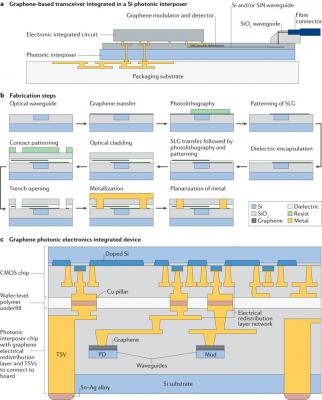Researchers affiliated with the Graphene Flagship have shown that integrated graphene-based photonic devices offer a unique solution for the next generation of optical communications. Researchers in the initiative have demonstrated how properties of graphene enable ultra-wide bandwidth communications coupled with low power consumption to radically change the way data is transmitted across the optical communications systems. This could make graphene-integrated devices the key ingredient in the evolution of 5G, the Internet-of-Things (IoT), and Industry 4.0.

"As conventional semiconductor technologies are approaching their physical limitations we need to explore entirely new technologies to realize our most ambitious visions of a future networked global society," explains Wolfgang Templ, Department Head of Transceiver Research at Nokia Bell Labs in Germany, which is a Graphene Flagship partner. "Graphene promises a significant step in performance of key components for optical and radio communications beyond the performance limits of today's conventional semiconductor-based component technologies." Paola Galli, Nokia IP and Optical networks Member of Technical Staff, agrees: "Graphene photonics offer a combination of advantages to become the game changer. We need to explore new materials to go beyond the limits of current technologies and meet the capacity needs of future networks."
Antonio D'Errico from the Graphene Flagship partner Ericsson Research explains how "graphene for photonics has the potential to change the perspective of information and communications technology in a disruptive way."
The team involves researchers from CNIT, Ericsson, IMEC, Nokia, Nokia Bell Labs, AMO, ICFO and the University of Cambridge. "This case exemplifies the power of graphene technologies to transform cutting edge applications in telecommunications. We already start to see the fruits of the Graphene Flagship investments when moving from materials development towards components and system level integration," explains Kari Hjelt, Head of Innovation for the Graphene Flagship.
Graphene photonics offers advantages in both performance and manufacturing over the state of the art. Graphene can ensure modulation, detection and switching performances meeting all the requirements for the next evolution in photonic device manufacturing. "We aim for highly integrated optical transceivers which will enable ultra-high bitrates well beyond one terabit per second per optical channel. These targeted systems will differentiate from their semiconductor-based forerunners by substantially lower complexity, energy dissipation and form factor going along with a higher flexibility and tunability," explains Templ.
Daniel Neumaier from Graphene Flagship partner AMO GmbH, also leader of the Graphene Flagship Division on Electronics and Photonics Integration, adds: "Optical communication links will become more and more important in 5G for supporting the required high data rates at all nodes. Graphene-based optical components integrated on a silicon platform will be able to deliver both increased performance and a low-cost production process, thus are expected to become key components in the 5G era."
"This paper makes a clear case of why an integrated approach of graphene and silicon-based photonics can meet and surpass the foreseeable requirements of the ever-increasing data rates in future telecom systems," says Andrea C. Ferrari, professor at the University of Cambridge, Science and Technology Officer of the Graphene Flagship and Chair of its Management Panel. "The advent of the Internet of Things and the 5G era represent unique opportunities for graphene to demonstrate its ultimate potential," he concludes.